The FCV's Erica Tramline
D Williams
The Erica Steel Tramway was used to transport sawn timber from sawmills located along the Eastern and Western Tyers Rivers to a siding joining the main Moe-Walhalla rail line just south of Erica in Central Gippsland. The tramway was one of two that were owned and operated by the FCV. The second was built in response to the needs of the 1939 salvage operation and extended from the South Cascade Bridge to Little Boys Camp. The locations of both lines can be found on this map.
The tramway travelled 6.75 miles from Collins siding, south of Erica, to the Tyers Junction where three river branches meet, those being the Eastern, Middle and Western Tyers. The tramway then spilt into two branch lines – one travelling 2.25 miles to ‘Ten Acre Block’ on the Eastern Tyers River, and the other travelling 7 miles to Growlers Creek on the Western Tyers River. It operated for 22 years, commencing in 1927 and its last trip was in July 1949.
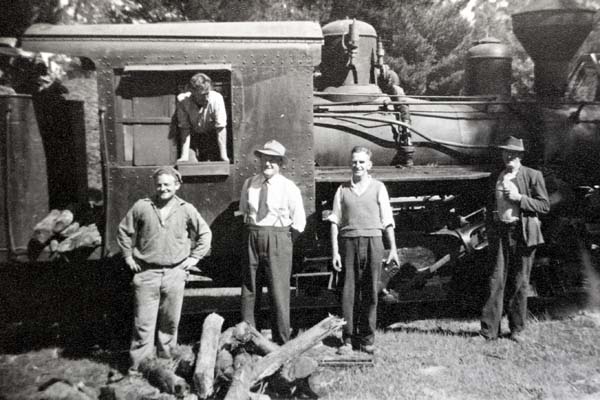
FCV-owned Climax Locomotive - Leaving Tyers Junction on the last trip.
l to r - F Cronin, AW Maxwell, H Whitehead, J Vennell, Unknown
Date: 1948
Source: FCRPA
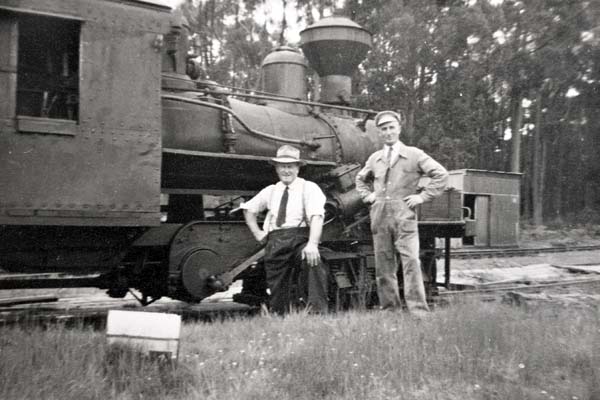
FCV-owned Climax Locomotive - at Tyers Junction.
l to r - H Whitehead, Unknown
Date: 1948
Source: FCRPA
Background
In the early days sawmills were built far into the forest, and poor transport severely limited the expansion of timber production from Victoria’s forests. The original mode of transport involved log-hauling bullocks and horse teams. Copying the success with narrow gauged railways for timber haulage in opening up forests in the United States, early wooden railed tracks worked by horses were introduced by sawmillers into Australian forestry. Following the first line in Victoria from Yarra Junction, railed tracks were built by millers to access forests on the slopes of Mt Erica.
The early tramways were inefficient and difficult to maintain. Several sawmillers from the Erica area approached the FCV requesting the construction of a steel tramway to replace the run down timber lines in 1925. A commitment was made and work started before the 1926 bush fires destroyed mills and the Mt Erica forests. The destruction of the forests heightened the necessity to construct a new steel tramway for salvage operations. The destruction and losses from the bush fires were severe. A large number of mill workers were instantly out of work with no income for their families. The Government gave an undertaking to provide £5,000 for the new tramway on condition the mill owners committed to re-build their mills and start again. Almost 100 mill workers were employed to construct the tramway, following which they would return to work at the re-built sawmills. A new alignment was surveyed and construction commenced in 1926 and the tramway was completed in 1927. Initially tractors were used to haul the trams while Australian ‘Harman’ steam locomotives were built. Unfortunately these were found to be unsatisfactory and a ‘Climax’ steam locomotive was imported as a replacement in 1928.
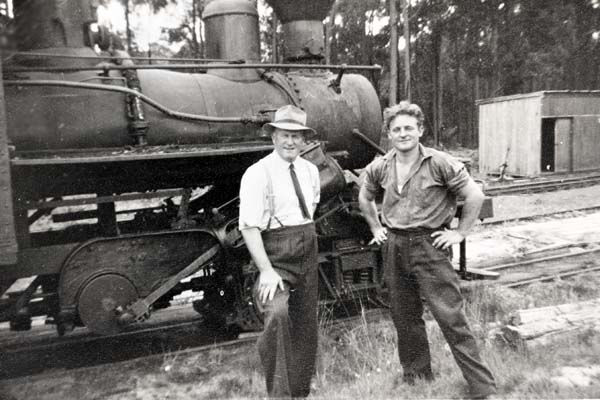
FCV-owned Climax Locomotive - at Tyers Junction.
l to r - H Whitehead, F Cronin
Date: 1948
Source: FCRPA
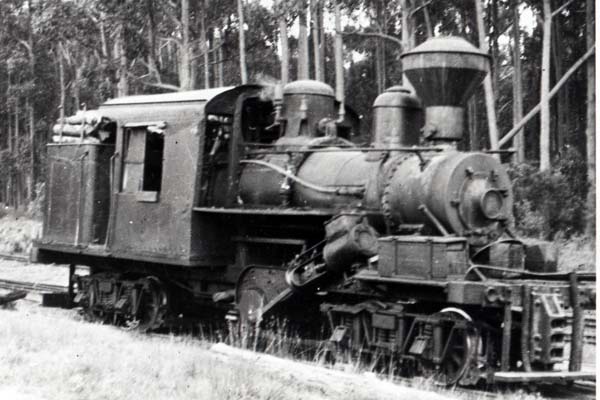
FCV-owned Climax Locomotive - at Tyers Junction.
Date: 1948
Source: FCRPA
Operation
The purpose of the tramway was to facilitate the extraction of timber from the slopes of Mt Erica, and it transported almost 120 million super feet of timber from Tyers sawmills as well as other produce including pulpwood and firewood. Annual timber volumes carted increased steadily for the first half of the tramway’s life to reach a high of more than 10 million super feet in 1935-36. Volumes fell steadily over the second half of its life with a little more than two million super feet carted in the last full year of operation in 1948-49. The enterprise generated accumulated revenue of almost £120,000. However, its’ operation was not a profitable with significant losses in most years particularly the second half of its life. This is notwithstanding concerns from saw millers that costs were too high. In 1929 the millers made representations to government that the tramway operation be taken over by Railways Department in anticipation that such management would be more cost efficient. The FCV successfully resisted the proposal.

FCV-owned Climax Locomotive - Leaving Tyers Junction on the last trip.
l to r - F Cronin, AW Maxwell, H Whitehead, J Vennell, Unknown
Date: 1948
Source: FCRPA
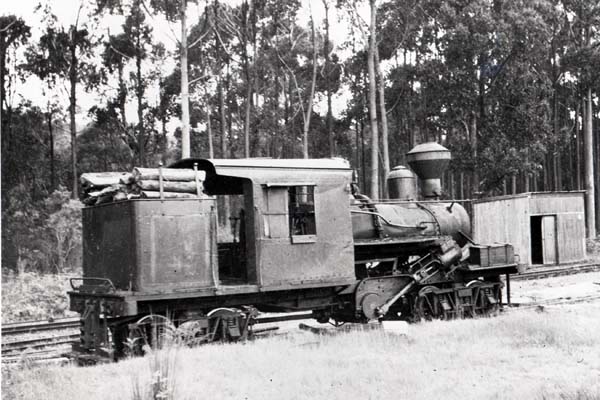
FCV-owned Climax Locomotive - at Tyers Junction.
Date: 1948
Source: FCRPA
Closure
The tramway ceased operation because of what was described by FCV as unsafe conditions of bridges and culverts. However, the declining level of business and significant losses would no doubt have been contributing considerations. A road from the main Moe-Walhalla road to Tyers Junction was completed in the year before closure and transport of the timber was by road truck from then on. The ‘Climax’ steam locomotive was acquired by Puffing Billy Preservation Society and has been restored.
"Following a major rebuild, Climax locomotive No. 1694 was returned to service on 8th September 2013, the 85th anniversary of its first entry into service on the Tyers Valley timber tramway, near Erica, Victoria. No. 1694 is one of only 19 Climax geared locomotives which survive worldwide and is unique in being the only one built to 2ft 6in (762mm) gauge.
The Tyers Valley tramway closed in 1949 and the locomotive was stored at Erica until it was transferred to Puffing Billy’s Menzies Creek museum for static display in 1965. In the 1980’s, Puffing Billy volunteers began its first restoration, which was completed in 1988. The locomotive was in operation until 2001, when it was noted that the boiler and other components needed a major overhaul." Source: Puffing Billy Railway
See Also
The Tyers Valley Tramway and FCV Climax 1694
The Climax was restored and operating at Puffing Billy in 2013.
Here is a more general gallery of tramline photos.
